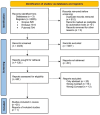A Scoping Review of the Use of Artificial Intelligence in the Identification and Diagnosis of Atrial Fibrillation
- PMID: 39590561
- PMCID: PMC11595485
- DOI: 10.3390/jpm14111069
A Scoping Review of the Use of Artificial Intelligence in the Identification and Diagnosis of Atrial Fibrillation
Abstract
Background/objective: Atrial fibrillation [AF] is the most common arrhythmia encountered in clinical practice and significantly increases the risk of stroke, peripheral embolism, and mortality. With the rapid advancement in artificial intelligence [AI] technologies, there is growing potential to enhance the tools used in AF detection and diagnosis. This scoping review aimed to synthesize the current knowledge on the application of AI, particularly machine learning [ML], in identifying and diagnosing AF in clinical settings.
Methods: Following the PRISMA ScR guidelines, a comprehensive search was conducted using the MEDLINE, PubMed, SCOPUS, and EMBASE databases, targeting studies involving AI, cardiology, and diagnostic tools. Precisely 2635 articles were initially identified. After duplicate removal and detailed evaluation of titles, abstracts, and full texts, 30 studies were selected for review. Additional relevant studies were included to enrich the analysis.
Results: AI models, especially ML-based models, are increasingly used to optimize AF diagnosis. Deep learning, a subset of ML, has demonstrated superior performance by automatically extracting features from large datasets without manual intervention. Self-learning algorithms have been trained using diverse data, such as signals from 12-lead and single-lead electrocardiograms, and photoplethysmography, providing accurate AF detection across various modalities.
Conclusions: AI-based models, particularly those utilizing deep learning, offer faster and more accurate diagnostic capabilities than traditional methods with equal or superior reliability. Ongoing research is further enhancing these algorithms using larger datasets to improve AF detection and management in clinical practice. These advancements hold promise for significantly improving the early diagnosis and treatment of AF.
Keywords: artificial intelligence; atrial fibrillation; diagnosis; scoping review.
Conflict of interest statement
The authors declare no conflicts of interest.
Similar articles
-
The Efficacy of Artificial Intelligence in the Detection and Management of Atrial Fibrillation.Cureus. 2025 Jan 8;17(1):e77135. doi: 10.7759/cureus.77135. eCollection 2025 Jan. Cureus. 2025. PMID: 39925585 Free PMC article. Review.
-
Artificial intelligence for breast cancer detection and its health technology assessment: A scoping review.Comput Biol Med. 2025 Jan;184:109391. doi: 10.1016/j.compbiomed.2024.109391. Epub 2024 Nov 22. Comput Biol Med. 2025. PMID: 39579663
-
Artificial Intelligence in Atrial Fibrillation: From Early Detection to Precision Therapy.J Clin Med. 2025 Apr 11;14(8):2627. doi: 10.3390/jcm14082627. J Clin Med. 2025. PMID: 40283456 Free PMC article. Review.
-
Artificial intelligence-enabled atrial fibrillation detection using smartwatches: current status and future perspectives.Front Cardiovasc Med. 2024 Jul 15;11:1432876. doi: 10.3389/fcvm.2024.1432876. eCollection 2024. Front Cardiovasc Med. 2024. PMID: 39077110 Free PMC article. Review.
-
Photoplethysmography based atrial fibrillation detection: a continually growing field.Physiol Meas. 2024 Apr 17;45(4):04TR01. doi: 10.1088/1361-6579/ad37ee. Physiol Meas. 2024. PMID: 38530307 Free PMC article. Review.
Cited by
-
Artificial intelligence in atrial fibrillation: emerging applications, research directions and ethical considerations.Front Cardiovasc Med. 2025 Jun 24;12:1596574. doi: 10.3389/fcvm.2025.1596574. eCollection 2025. Front Cardiovasc Med. 2025. PMID: 40630898 Free PMC article. Review.
References
-
- Shotan A., Garty M., Blondhein D.S., Meisel S.R., Lewis B.S., Shochat M., Grossman E., Porath A., Boyko V., Zimlichman R., et al. Atrial fibrillation and long-term prognosis in patients hospitalized for heart failure: Results from the Heart Failure Survey in Israel [HFSIS] Eur. Heart J. 2010;31:309–317. doi: 10.1093/eurheartj/ehp422. - DOI - PubMed
-
- Tsang T.S., Gersh B.J., Appleton C.P., Tajik A.J., Barnes M.E., Bailey K.R., Oh J.K., Leibson C., Montgomery S.C., Seward J.B. Left ventricular diastolic dysfunction as a predictor of the first diagnosed nonvalvular atrial fibrillation in 840 elderly men and women. J. Am. Coll. Cardiol. 2002;40:1636–1644. doi: 10.1016/S0735-1097(02)02373-2. - DOI - PubMed
Publication types
LinkOut - more resources
Full Text Sources


